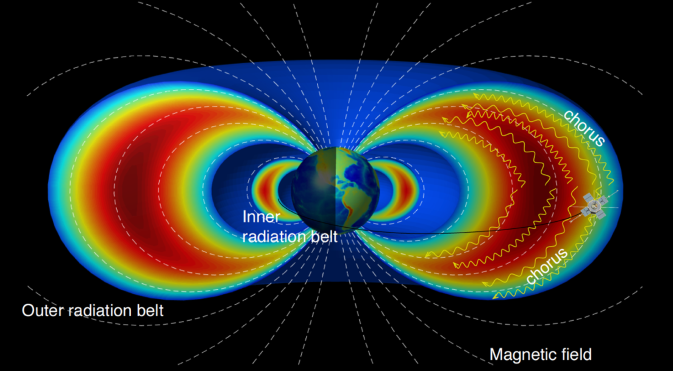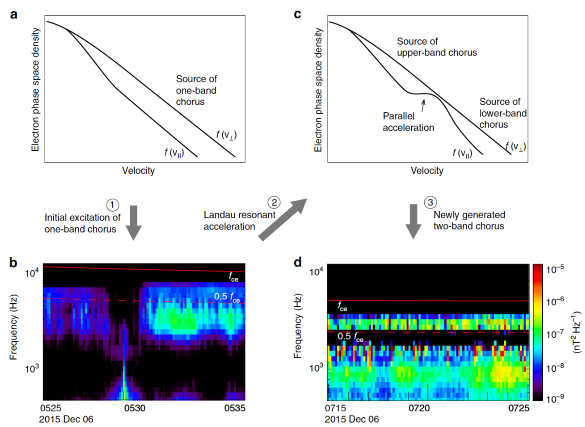Space is playing chorus, with high and low pitches
(Los Angeles, December 10, 2019) Researchers in the Bortnik group at UCLA recently revealed why the “chorus” in the Earth’s space have two distinct frequency bands, which is a 50-year-old important question in space physics. The mechanism is revealed from NASA’s Van Allen Probe data and computer simulations. This research is recently published on Nature Communications.
The space environment around the Earth is not empty. It is filled with ionized particles that are known as plasmas. Space is not ‘silent’ either. Fluctuations of magnetic and electric fields and moving particles produce various kind of electromagnetic waves, which early scientists studied by listening to their audio signatures.
In the Earth’s outer radiation belt, which consists of relativistic particles moving with speeds that are close to the speed of light, one of the most beautiful “musical sounds” in space is produced, namely, chorus waves. Their audio sounds like the dawn chorus of birds and thus got its name. Their existence was known even before the launch of the first satellite, because they can propagate roughly following the magnetic field to the ground. In the space age, satellites were able to directly detect those emissions in space. Early satellite measurements 50 years ago discovered that chorus emissions typically consist of two frequency bands, the upper-band and the lower-band, separated by a gap in spectra. The voyager mission later found that chorus emissions in the space of Jupiter and Saturn also have two distinct bands. The origin of the two-band signature of chorus has since then been intensively studied by many scientists.
In 2012, NASA launched the twin spacecraft known as the Van Allen Probes, named after the discoverer of the radiation belts, James Van Allen. As part of the Living With a Star program, this mission was designed to explore the radiation belt environment and its variability. Soon after the launch, the satellite data shows that the relativistic electrons are accelerated by chorus emissions in the heart of the outer radiation belt. The Van Allen Probe data also confirms that chorus emissions cause diffuse aurora. The origin of characteristic banded chorus has thereafter become one important question.
Recently, Dr. Jinxing Li, Prof. Jacob Bortnik and their collaborators at UCLA analyzed the data collected by Van Allen Probes, and reported that the two-band chorus waves are commonly accompanied by two separated unstable electron populations. Using computer simulations, they demonstrated that freshly injected electrons can generate one single chorus band. But the initial chorus emissions can quickly feed back to the electron populations and stabilize the electrons at medium energies (typically to the order of ~1/10 light speed). This naturally divides the unstable electrons into a low and a high energy components, which then excite the upper-band and lower-band chorus, respectively.
Prof. Jacob Bortnik leads a team at UCLA that focus on the radiation belt dynamics and the origin of various kind of waves in space. He previously revealed that the hissy emissions in space originate from chorus waves by linking observations from two coordinated satellites. Jacob is also a pioneer that utilize artificial intelligence to model space environment. Jacob constructed a global electron density model in the Earth’s near space using machine learning technique and multi-spacecraft observations. Later, utilizing more spacecraft in different orbits, the team constructed a 3-D dynamics electron density model, which is more realistic and accurate then previous models.
Dr. Jinxing Li received his PhD from Peking University, and since then has worked at UCLA as a postdoc. He made several novel discoveries in space physics, including the cause of the radiation belt electron butterfly distributions. Recently, he as the principal investigator received a NASA Living With a Star grant which aims to model the ring current dynamics that encircles the Earth in response to solar wind drivers using machine learning.
Reference: Li, J., Bortnik, J., et al. (2019), Origin of two-band chorus in the radiation belt of Earth, Nature Communications, 10, 4672, https://doi.org/10.1038/s41467-019-12561-3














